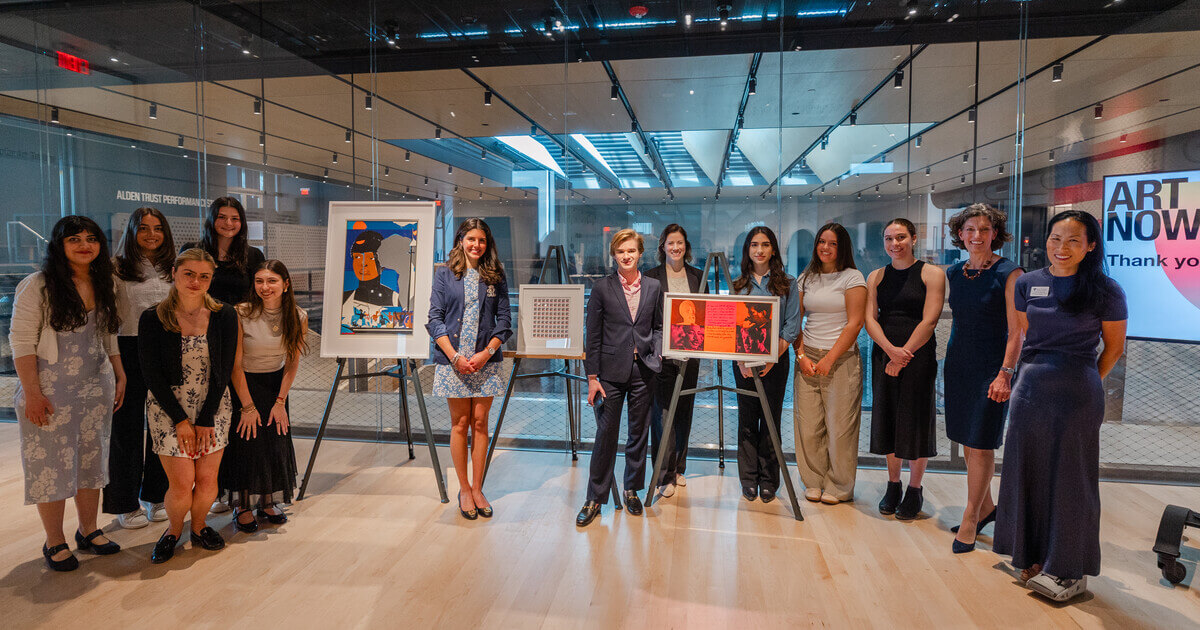
Regina Palladino ’27, a studio art and English double major, was drawn to the class for political reasons.
“I have always taken an interest in activist artwork and felt strongly that art is one of the most powerful outlets to voice opinions and fight oppression,” Palladino said. “I knew that the course would not only make me a more well-rounded student, but also make me a better artist.
I felt myself growing as a student and a professional as this class has progressed.”
The course also helped Palladino rid herself of certain apprehensions she felt at the idea of approaching and working with art professionals. Her first foray into the business side of art was an email to a gallerist based in Philadelphia. He responded enthusiastically, which made it easier for Palladino to speak with him in person at a New York print fair regarding a piece she was interested in presenting to the class.
“Selecting three amazing artworks for the Cantor together with my classmates was absolutely the most rewarding experience,” Palladino said. “After much debate and discussion, we selected artwork that we are all passionate about and feel will improve the Cantor’s inventory.”
‘What story do we want to tell?’
“The students did a really nice job of balancing their interests with thinking about the institution and what gaps need to be filled, what voices are missing,” Trafton said. “And then, since the collection is at Holy Cross, what does acquiring this art mean for the College? What does it mean for Worcester?”
“The students’ impact is going to be lasting because the work they acquire stays here,” Szumita adds. “We offer a lot of classes here on social justice, so we want to think about what kinds of activist works we can show to support conversations in the classroom. And, collectively, we’re never going to have an encyclopedic collection, but we can say something with the collection we have. What story do we want to tell?”
White says she and her classmates relished the opportunity.
“Toward the end of the course, when we were finalizing our choices, the discussions became very passionate,” she said. “It was cool to see everyone so invested in what we were doing, not only for our class but for the future of the Cantor Art Gallery and future Holy Cross students.”
White was an early champion of Kruger’s “Untitled Stamps,” a print that mimics the look of a page of perforated postage stamps. “Untitled Stamps” features a single, repeated black-and-white photo of a woman’s hand holding a pocket watch under which is a red band containing a single word rendered in Futura font. The words describe various emotional states such as “relaxed,” “happy,” “hopeful,” and “awake.”
“I believed it would serve the collection well,” she said. “By the end of our discussions, the entire class valued that piece as one of our top potential acquisitions. It was extremely rewarding to advocate for something I felt strongly about and see that have an impact.”
Andrew Witkin of Boston’s Krakow Witkin Gallery consulted with the class throughout the semester and praised the students’ professionalism.
“I was impressed by the close-looking, deep-thinking, and mature commitment to exploration that the students showed,” he said. “They were given a responsibility and dealt with it in a mature and respectful manner that sets the bar very high for future acquisitions.”
Palladio offers this advice for future students: “I would suggest looking at the artists currently participating in larger art fairs and biennials. This will give you a sense of the current tastes and talents. Our art history courses at Holy Cross tend to focus more on work of previous generations and the art canon; this class demands a new approach where you must stay updated on the current events in the art market.”
Spoken like a professional.
